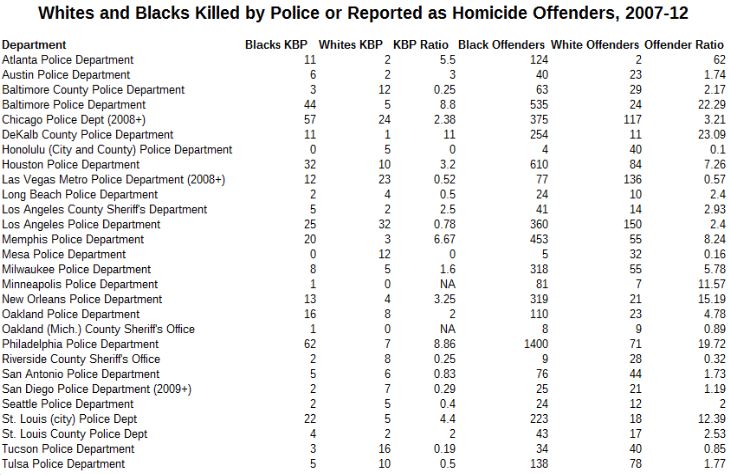Race and Police Killings Reconsidered
Over the past six months there's been a lively discussion about the demographics of those killed by police -- a discussion haunted by the fact that the government's data on this topic are not particularly good. Vox provided an overview in August; ProPublica made the striking claim in October that black males in their late teens are killed at 21 times the rate of their white male peers; Slate argued that ProPublica's disparity couldn't be explained by racial differences in overall violent-crime rates (drawn from a victimization survey); I reanalyzed the FBI data and found that blacks are actually more heavily represented among homicide offenders than among those killed by police.
Now we have something of a breakthrough: The Wall Street Journal directly contacted more than 100 of the nation's largest police departments, asked for data about police killings from 2007 to 2012, and then compared these numbers with those the departments had reported to the FBI. It was no surprise that the numbers were a mess, with some agencies completely missing from the FBI numbers and others reporting far more (or even fewer) police killings to the paper than they had to the federal agency. The paper's overall tally was 45 percent higher than the FBI's for these departments.
But this exercise did uncover 28 departments that seem to have it more or less together -- where the number reported to the FBI was between 90 and 110 percent of the number provided to the WSJ. Delving deeper into these departments' FBI data, I was able to shed light on two questions: In these jurisdictions overall, are blacks shot by police more often than their involvement in homicide -- as reported by the same departments, in the same FBI report -- would predict? And how do these numbers work out for individual departments?
Because of the focus on large police departments, this analysis can't be nationally representative. But it can give us a better picture of what's going on in some of the nation's urban areas.
I looked at victims and offenders who were (A) identified as black or (B) identified as white but not also as Hispanic. (See the final paragraph for some methodological decisions I made that excluded some cases.) Bottom line: Between 2007 and 2012, these departments told the FBI they killed 1.7 blacks for every white they killed (374 vs. 220). They also reported 4.9 blacks as homicide offenders for every white reported (5,773 vs. 1,171). In other words, the racial disparity in homicide offenders is nearly three times that in police killings. This is an even bigger gap than I found when I used all the data in my earlier post (0.82:1 vs. 1.5:1, itself nearly double).
Want more numbers? Here they are, department by department. Bear in mind that each jurisdiction here has its own demographic mix, so the most fruitful comparison will be between the two black-to-white ratios for each department (one for those killed by police, one for those identified as offenders):

To be sure, this leaves a lot of room for debate. Even if there are no statistically problematic patterns, there may be bias in individual cases. And maybe homicide reports aren't the right baseline to use, especially since that approach suggests an anti-white bias on the part of police officers, which seems unlikely given how white police departments tend to be. Perhaps there's bias in the reporting process, or perhaps homicide offenders are not representative of the people who get into lethal confrontations with police officers. But at the very least, the introduction of homicide data reveals a whole new way of looking at the numbers.
You can download the FBI's Supplementary Homicide Reports here, a spreadsheet I made of numbers from the Wall Street Journal report here, and the R code I used to generate the statistics in this post here. Please e-mail or tweet me if you have questions, suggestions, or comments.
Finally, here's a technical note to explain some decisions I made and some differences between my analysis and the WSJ's. The WSJ excluded some years for some departments from its data, so I did too. If a victim or offender's race was marked as white but the ethnicity (Hispanic/non-Hispanic) wasn't listed, I counted the person as white. The Riverside and Los Angeles county sheriff's departments also report for "contract cities" they're responsible for; the WSJ went through the trouble of sorting out the quirks of these arrangements and including all the jurisdictions, but for the sake of simplicity I kept my numbers to the core departments. Also for the sake of simplicity, I kept my analysis to the victims and offenders listed first in each incident report, as I did in my previous post, whereas the WSJ hunted down the secondary victims lurking here and there in the data. A big thanks to Rob Barry, the lead author of the WSJ piece, for helping me sort out many of the details above.
Robert VerBruggen is editor of RealClearPolicy. Twitter: @RAVerBruggen




